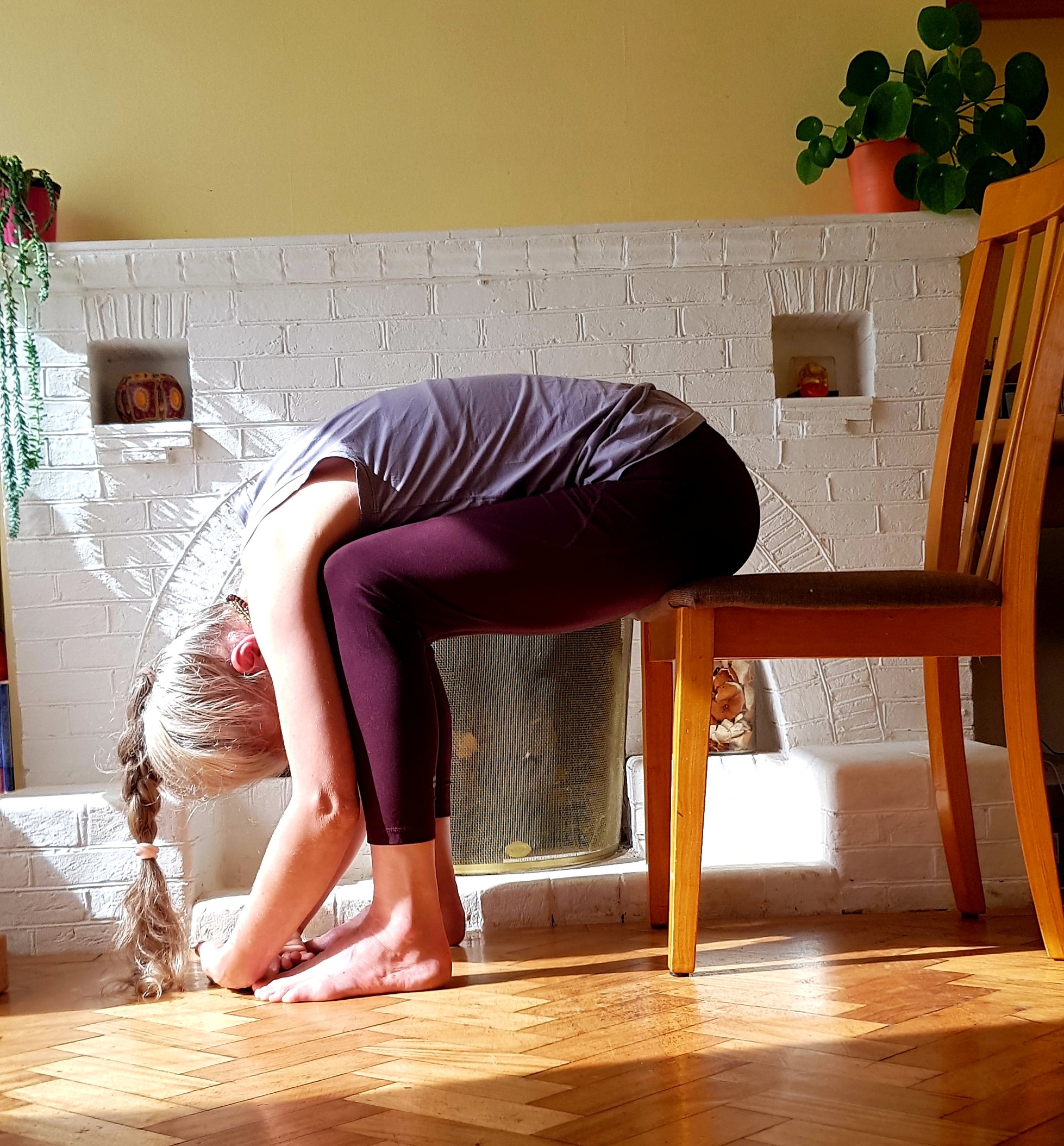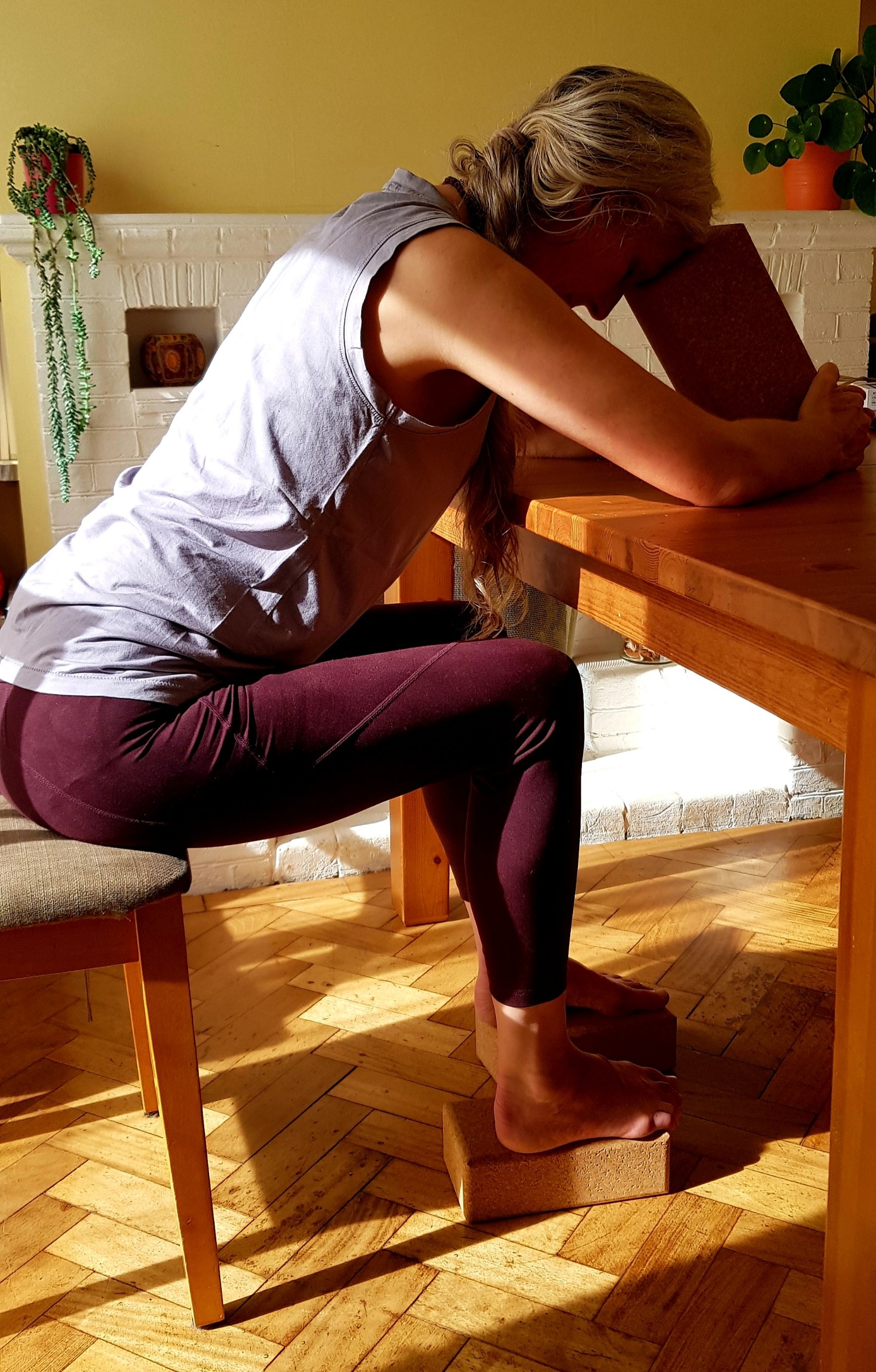Uttanasana for a clear and calm mind
What is Uttanasana?
Uttanasana is a standing forward bend.
Uttanasana is a Sanskrit word meaning: Uttana – intense stretch Asana – posture or seat
4 reasons why we practise Uttanasana
Here are some enticing benefits which make the work that most of us need to put into Uttanasana worthwhile.
Uttanasana
is calming and cooling for the brain and nervous system.
at the same time, it refreshes the brain when feeling low or tired.
supports the digestive system by strengthening the abdominal organs, and toning the liver, spleen, and kidneys according to BKS Iyengar.
the full pose helps to relax the tops of the shoulders, arms, and neck.
These benefits make Uttanasana an excellent posture for all seasons.
Cooling is great for the hot summer months.
Calming helps the jittery Vata mind during autumn and winter.
The strengthening effect on the digestive system when combined with deep abdominal breathing is helpful for the more sluggish Kapha springtime.
How to practice Uttanasana
As mentioned above, anatomically, Uttanasana is straightforward. These instructions are for the full pose. If you are not familiar with the pose or experience any back issues, please start practising with any of the easier versions below.
Stand with your feet hip-width apart.
Bring the outside edges of your feet parallel to the edge of your mat.
INhale lengthen your spine, and raise your arms overhead.
EXhale soften your knees, and fold forward from your hips as you sweep the arms sidewards down (this is called swan dive, which is easier on the back than arms forward).
IN peel your upper body away from your legs into half forward bend.
EX draw the navel and lower abdomen back to the spine and fold further forward.
Keep breathing deeply into the lower back and back of your legs, and wherever your body needs space and softening.
Place your hand on the floor in front of your feet or next to your feet.
With each exhale draw the navel and abdomen back, and keep lengthening the spine.
Relax your neck and head.
To return:
IN soften your knees, strongly press the floor away with your feet and sweep the arms again sidewards up as you sit slightly back with your hips, then straighten your legs to come back up into standing.
Back in standing wait for a couple of moments in case you feel lightheaded or dizzy.
Make it challenging
Naturally, not everyone has tight hamstrings. So some of you might be able to bend forward into the full pose with ease and look for ways to challenge yourself a little more.
Here are some ideas:
Hook your index- and middle fingers around our big toes and draw the elbows slightly back.
Place your hands underneath your foot soles, palms up to meet the foot soles.
Hold your heels with your hands and draw your elbows back.
Always remember to keep lengthening the front of your body and to engage the front of your thighs, to safeguard the knees and avoid collapsing in your torso.
Uttanasana is one of the poses which can spark your ambition.
If you notice these thoughts surfacing, let go of them and bring your focus back to your breath.
Helpful Anatomy
Anatomically, this pose is straightforward with hip flexion as its main movement. But is it equally easy?
In the true meaning of the word, it is an intense stretch of both the hamstrings, the muscles group at the back of our thighs, and the muscles of your back.
So, Uttanasana stretches the entire back of the body from the heel to the crown of the head.
Whenever we move, might it be walking or running, our hamstrings contract, and get shorter, to bend the knee. So naturally, the hamstrings tend to shorten more as this is the action, they perform the most.
This means that in Uttanasana they need to move against their natural day-to-day actions. As we are talking about long muscles here, connecting sit bones with the lower legs, lengthening these long muscles is a matter of patience.
Mind your Back
If you know that you have an underlying lower back issue, please be mindful.
Forward bends, in general, are tough on the lower back. This is because the discs of the lumbar vertebrae can get compressed and might press on nerves leaving the spinal cord between the vertebrae if we don't try to keep lengthening them.
If you have issues with your lower back, be careful and listen to your back, and be patient.
Another Gem for Women
Did you know that some Yoga postures are extremely beneficial for women?
Uttanasana is one of them.
Again, according to BKS Iyengar, Uttanasana helps to relieve menstrual pain and cramps.
Breathing gently into the lower abdomen massages the tissues and helps them to relax, which eases cramps and pains.
Always warm-up
Uttanasana is an intense stretch. It is super important to warm your hamstrings up before you practise the pose.
A great way is moving dynamically from squat to easy Uttanasana.
Start in an easy squat. Bend your knees as comfortable, this can be as if you would sit on a chair or further down toward a full squat, whatever feels comfortable.
Lift your hips with an in-breath, and straighten your legs as comfortable.
Exhale, back down to squatting.
Ways to make it easier
As it can be a challenging pose, here are some tips to make it easier:
In case your lower back is tight, or you have a lower back issue, practise Ardha Uttanasana using a table. Place your hands on the table and walk back as far as comfortable, start lengthening your back.
To help lengthen your hamstrings keep your knees bent. Breathe deeply into the back of your legs, and soften and lengthen these long muscles. Be patient. Whenever a sense of length develops, straighten the legs a little more.
If standing feels too much, practise Uttanasana sitting on a chair.
How about a Restorative Pose?
Sometimes we need a few minutes of time out.
This restorative version of Uttanasana is a great pick-me-up during lunch break or in the evening. Strictly speaking, it is not a standing forward bend; your head stays above your heart. It is a forward bend though and it is super comfortable and easy to practise.
I am using a block in this picture, if you don’t have a block handy, use a couple of cushions or blankets to support the head. The head needs to be in line with the spine, avoid dropping the head down. Keep your elbows further away to relax the shoulders as much as possible.
To keep the hips and legs relaxed, place blocks underneath your feet, firm blankets work well too.
It is surprisingly easy to drift off in this pose, so if you have to be somewhere afterwards, make sure you set a gentle alarm to keep you on track.
————
Keep practising the wonderfully calming pose. Integrate it into your routine and adapt it to what your body needs.
It is always best to practise with and learn from a teacher.




